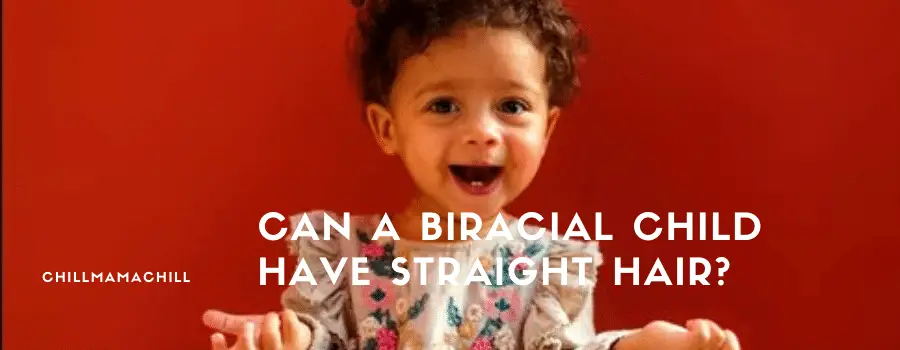Multiracial looks are an age-old conundrum but usually boils down to dominance’s mixed heritage and genetic facets. A baby born half one race and half, or quarter and so on of the other, comes out with their unique appearance, except maybe to their siblings. So, can a biracial child have straight hair instead of curly or kinky?
Yes, a biracial child can have straight hair depending on the parent’s genealogy or, in other words, racial background. Not all mixed-race babies ‘ hair curls, and sometimes it’ll be if it’s wet but straighten out when it dries. The straightness or curliness of hair is influenced by the size and shape of hair follicles, determined by genetic factors.
Biracial hair is its type, and it can take any shape, form, texture, and more colors than it is common among mainstream races. In some cases, a mixed-race child will have multiple curls patterns or a mop that’s uncharacteristically straightened. If you’re wondering what the probabilities of your child having straight hair are, read further.
So, Can a Biracial Child Have Straight Hair, and Is It Normal?
Having straight hair isn’t such an anomaly in biracial offspring. A mixed-race baby will often have chocolate-colored skin that’s topped by a full head of soft, straight, curled, or kinked hair. That’s because the natural categorization of interracial means any combination of genetic factors can give rise to rarely before seen traits, including straight hair mixed in with another that’s curled.

The challenge comes in classifying biracial hair accurately, seeing as the combinations are unlimited, all with different forms or textures. Multiracial hair is unique, so much so that one type will have several thicknesses, patterns, and curls.
Hairstyling systems of typing or categorizing measure interracial babies’ hair curling where one is the straightest while four is the most coiled. Each category is further sub-classified as a, b, or c based on the coil, wave, or curl diameter. Type one, which is biracial straight hair, has three categories that include;
- 1a, which is straight with a fine thin texture
- 1b is straight with slight bending
- 1c is a straight variety but coarse in texture
Limited research has been conducted on biracial hair, but a study in 2019 found that hair strands that were straight measured less thick than those from curly-haired mixed-race women. As is common among interracial babies, several interspersed textures can cause breakage resulting from tangling.
How Genetics Play a Role in Making a Biracial Child’s Hair Straight?
According to a trusted medical source, hair strands contain three main components. These include the medulla or the core, the cortex surrounding it, and a cuticle, a layer of scales covering the medulla. It’s not clearly understood how hair straightens or curls, but the cortex significantly affects texture and form patterns.

Inside the cortex are three different types of cortical cells, each containing separate arrangements of filaments made up of the protein keratin. That’s the same stuff that protects your nails, and the difference in cellular makeup determines a strand’s curl or straight pattern. The influencing factor for biracial hair thickness, texture, and curl pattern is genetics, which equates to racial heritage.
Different genetic traits influence hair thickness and texture depending on ethnicity. Completely unrelated genes will play a role in determining the thickness and curl patterns of Asian hair, as opposed to East African strands. It’s only now that researchers are beginning to understand which genes contribute to various hair types, especially in biracial children.
Though hormones will determine the type or thickness of hair, another factor plays a part in your biracial baby hair’s texture. The shape of hair follicles or the skin openings through which strands grow determines whether the hair is straight, wavy, or curly. Curly hair dominates the genotype, so straight strands are often the result of two straight-haired biracial genetic traits.
How Can I Take Care of My Child’s Biracial Straight Hair?
Of all biracial hair types a child can have, the straight variety has to be the easiest to care for. If you keep it well shampooed and moisturized, it beats having to untangle coarse, dry, frizzy curls, especially in kids that don’t want their heads touched. However, the best hair care approach will hinge on the hair’s weight or thickness, texture, and length instead of curled or straight.
Tangling is the number one worry that most mums with biracial children face. Damage often happens at the roots due to different thicknesses and types working against each other. Another factor for consideration in keeping well-groomed mixed-race hair is porosity. That’s the attribute that describes how well hair can hold moisture, and wavy, straight strands have the highest porosity.
For straight hair on your biracial child, use light sprays or flexible lotions that cause matting. The hair type is usually thin, not likely to frizz or tangle, but it’s also prone to breakage if left to dry. A few tips on keeping your mixed-race child’s straight hair healthy include;
Not Shampooing Daily
Biracial hair doesn’t need to be shampooed every day as it strips off natural oils necessary for healthy strands. You can wipe off any dirt during daily washes and then moisturize your mixed-race child’s straight hair, only applying shampoo at most once a week.
Using Protective Styles to Prevent Breakage
It’s common for straight biracial hair to suffer breakage, which you can prevent with twists, braids, or ribbons.
Use a Wide-Toothed Comb
Hairbrushes and fine-toothed combs not only irritate the scalp but also contribute to hair breakage. Avoid rubber bands and pulling hair too tight, so keep braiding loose.
Treat Cases of Cradle Cap
Use medicated shampoo specially formulated to reduce cradle cap flaking and dryness. For other conditions that cause hair loss, consult your pediatrician before using any product.
Conclusion
So, can a biracial child have straight hair? There’s nothing typical when it comes to mixed-race. There’s also no telling which dominant or recessive gene will come into play, giving your baby a unique mop that’s the subject of conversation. The causes lie somewhere within the interracial heritage, coming off the cauldron of ancestral aesthetic traits.

I’m Cathrine and I’m a 39-year-old mother of 3 from Utica, New York. And I’m extremely happy you’ve come to visit my hide-out on the web. Here I post about everything related to family-life and usually it will involve babies and lessons I’ve learned over the years from experts, friends, and my own mistakes. So hopefully you will find what i write fun and informational!


